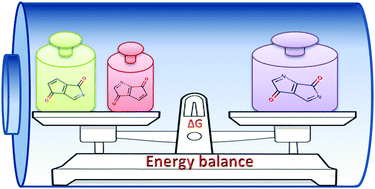Playing with isomerism and N substitution in pentalenedione derivatives for organic electrode batteries: how high are the stakes?†
Abstract
New concepts to design innovating and top-performing redox-active organic molecules based electrodes should push forward and promote an eco-friendly alternative to classical Li-ion batteries. In this promising research area, density functional theory calculations lend support to experiments through the prediction of redox voltage and give promise to rationalize the trends, thus providing a general approach for engineering advanced materials. In this study in which we analysed spin density/net atomic charges distribution along with global energy decomposition thanks to Bader's partitioning of the molecular space, a vision for designing pentalenedione derivatives by fine tuning of the redox potential properties is presented. The concept relies on combined effects of isomerism and N single/double substitution for CH on the parent backbone. Such dual nature modification is able to provide a series of compounds within the range of 2.2–3.6 V vs. Li+/Li (against a more restricted range of 2.2–2.8 V vs. Li+/Li for the sole effect of isomerism on the unsubstituted parent compounds). The incidence of double N substitution alone generally follows an almost additive rule based on the combined actions of the composing single N substitutions. Few exceptions to the rule were, however, also observed and rationalized. Beyond learning gained for this peculiar family, these results may have exciting implications for future design strategies.


 Please wait while we load your content...
Please wait while we load your content...